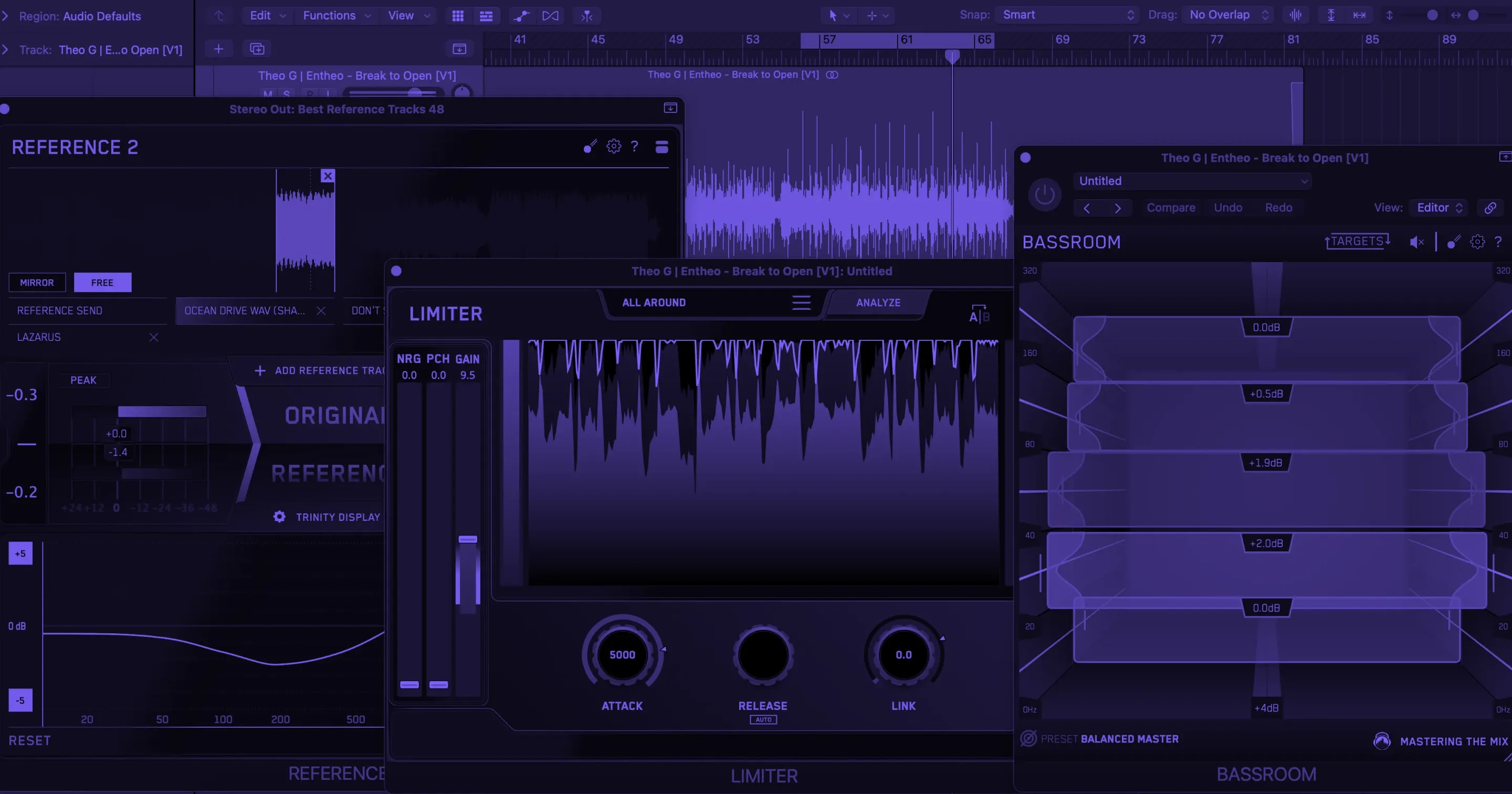
Mastering Your Music: The Final Polish to a Professional Sound
Learn what music mastering is and how to add the final polish to your tracks. This guide covers essential techniques, tools, and mastering for streaming services.
Introduction
In the world of music production, the journey from a raw recording to a polished, release-ready track involves several critical stages. The final and often misunderstood step in this process is mastering.
It's the bridge between the final mix and the listener, ensuring that your music translates effectively and professionally across all playback systems, from a high-end club sound system to a pair of everyday earbuds.
This article will delve into the art and science of music mastering, exploring its purpose, the essential techniques involved, and the tools of the trade.
To get the most out of this guide, we recommend starting with our article explaining the key differences between mixing and mastering. This is especially useful if you’re a complete beginner when it comes to post-production tasks.
What is Music Mastering and Why is it Crucial?
At its core, music mastering is the final quality control and enhancement process for a song, EP, or album. A mastering engineer takes the final stereo mix of a track and applies subtle but crucial adjustments to optimize its sonic characteristics for distribution.
The primary goals of mastering are:
The Mastering Toolkit: Essential Gear and Software
While the ears and experience of the mastering engineer are the most crucial tools, they rely on a combination of specialized hardware and software to achieve their results.
A typical mastering setup includes:
Alongside monitors, high-quality mastering headphones are indispensable for fine-tuning details. They allow an engineer to zoom in on subtle clicks, pops, reverb tails, and other nuances that might be missed on speakers. For this reason, many professionals rely on specialized headphones.
For example, Musiversal mastering engineer Luciano Vassão works with Audeze headphones, known for their exceptionally detailed and non-fatiguing sound that allows for hours of critical listening.
There's no single “best” software for mastering, as many great companies offer professional-grade tools. Ultimately, it comes down to an engineer's personal taste in workflow and interface.
Within the Musiversal audio engineering team, for example, you'll frequently find them relying on comprehensive suites like iZotope Ozone, alongside acclaimed bundles from FabFilter and Slate Digital for their unique sonic characteristics.
The Mastering Process: A Step-by-Step Guide
While every track is unique, the mastering process generally follows a logical sequence of steps.
1. Critical Listening and Reference Tracks: The first and most important step is to listen intently to the mix in a controlled environment. The mastering engineer will identify its strengths and weaknesses and compare it to well-mastered commercial tracks in a similar genre. This provides a clear sonic target.
2. Corrective Equalization (EQ): Before enhancing the track, any sonic problems in the mix need to be addressed. This might involve using a precise EQ to notch out resonant frequencies, tame harshness, or clean up muddiness in the low-end.
3. Tonal Shaping with EQ: Once the mix is balanced, a broader, more musical EQ might be used to enhance the overall tone. This could involve a gentle high-frequency shelf to add"air,"a subtle low-end boost for warmth, or a slight midrange scoop for clarity.
4. Compression for Dynamics and Glue: A compressor with a low ratio and slow attack time can be used to gently even out the dynamic range, making the track feel more cohesive and punchy. The goal is to control dynamics transparently, not to squash the life out of the music.
5. Stereo Enhancement: If the mix feels narrow, a stereo imaging tool can be used to subtly widen the soundstage. It's crucial to be gentle here, as overuse can lead to phase issues and a weak center image. A common technique is to make the low frequencies mono to maintain a solid foundation.
6. Saturation and Harmonic Excitement (Optional): To add a touch of analog warmth or subtle character, a saturation plug-in can be used. This should be applied with a light hand, as a little goes a long way.
7. Limiting for Loudness: The final step in the audio processing chain is the limiter. This powerful tool increases the perceived loudness of the track by preventing the audio signal from exceeding a set ceiling (typically just below 0 dBFS). The key is to achieve a competitive loudness level without introducing audible distortion or sacrificing too much of the track's dynamic punch.
8. Dithering and Exporting: Dithering is a process that adds a very low level of noise to the audio when converting to a lower bit depth (e. g., from 24-bit to 16-bit for CD). This helps to minimize quantization distortion. Finally, the mastered track is exported in the appropriate formats for the intended distribution platforms.
It’s worth repeating that a fundamental rule in audio is that mastering cannot fix problems created during the mixing stage. To ensure your track is truly ready for that final polish, Musiversal members can book a Mix Advice session with a professional engineer. This expert feedback helps you resolve issues and submit a mix that's polished, balanced, and prepared for a professional master.
Mastering for Different Formats: Streaming, Vinyl, and CD
The final destination of the music significantly influences the mastering approach, as each format has unique technical requirements.
Mastering for Streaming Services (Spotify, Apple Music, etc.)
These platforms use loudness normalization to create a consistent volume for all songs. This means that if a master is pushed to be excessively loud, the service will simply turn it down. Therefore, the focus is on a healthy dynamic range rather than maximum volume. Masters are typically aimed at a target loudness (around -14 LUFS, a standard unit for measuring perceived loudness) and the audio's highest point, or True Peak, is kept below -1 dB to prevent distortion when the file is converted to a streaming format like MP3 or AAC.
Mastering for Vinyl
Vinyl is a physical medium with specific limitations for the cutting stylus that carves the groove. Two key issues are:
Mastering for CD
The CD has a fixed digital format: a bit depth (audio resolution) of 16-bit and a sample rate (digital snapshots per second) of 44. 1 kHz. When converting a high-resolution master (e. g., 24-bit) down to the 16-bit CD standard, a process called dithering is essential. Dithering adds a very subtle layer of noise that masks audible errors and artifacts that would otherwise occur during this conversion, resulting in a cleaner final sound.
Professional Mastering Engineer vs. DIY
In an age of accessible and powerful software, many musicians are tempted to master their own music. While this can be a valuable learning experience, the role of a professional mastering engineer should not be underestimated.
A mastering engineer brings:
When to DIY: For demos, personal projects, or if you're on a tight budget, DIY mastering can be a viable option. There are also automated online mastering services that can provide a quick and affordable solution, though they lack the nuance and personalized touch of a human engineer.
When to Hire a Pro: For commercial releases, albums, or any project where you want to present your music in the best possible light, investing in a professional mastering engineer is highly recommended.
The Mastering Mindset: Objectivity, Subtlety, and Knowing When to Stop
Beyond the technical skills, a successful mastering engineer possesses a specific mindset:
In conclusion, mastering is the final, crucial step that transforms a well-crafted mix into a professional and impactful piece of music ready for the world to hear. Whether you choose to embark on the journey of learning to master your own music or entrust your work to a seasoned professional, understanding the principles and processes behind this essential stage of music production will undoubtedly elevate the quality of your final product.
Whether you want to learn the theory or get practical experience, Musiversal has post-production options to support you. You can sharpen your skills by receiving direct feedback on your project in a Mixing Feedback Session or engaging in a broader discussion with an engineer during a Meet-and-Greet. When you're ready to practice mastering, you can order a Quick Mix to receive a professionally balanced track, giving you the ideal starting point to apply what you've learned.
Your Music, No Limits.
Join the Waitlist